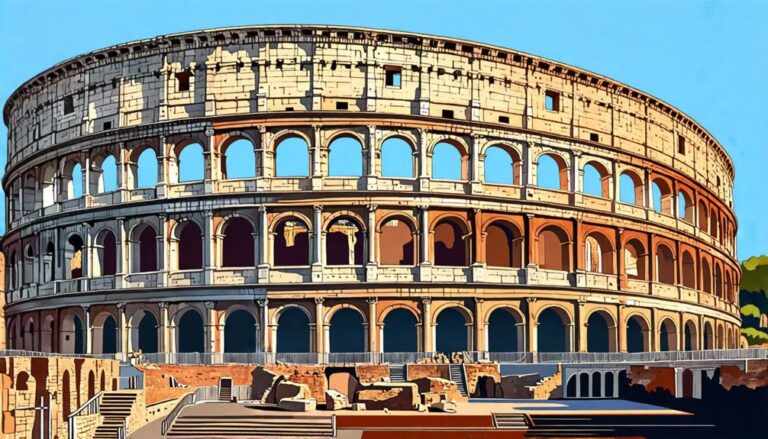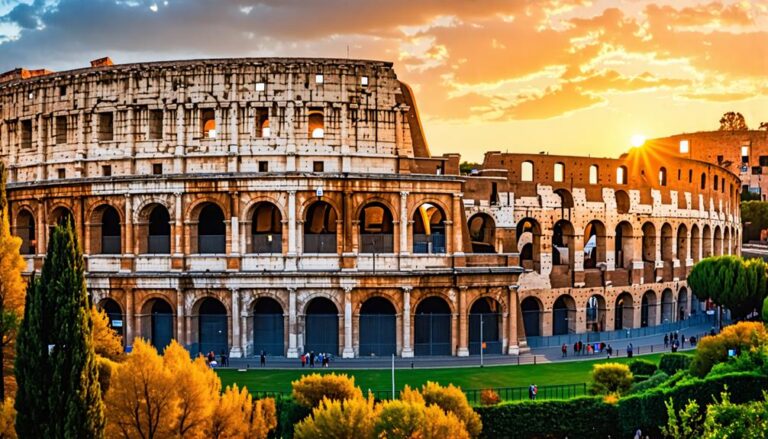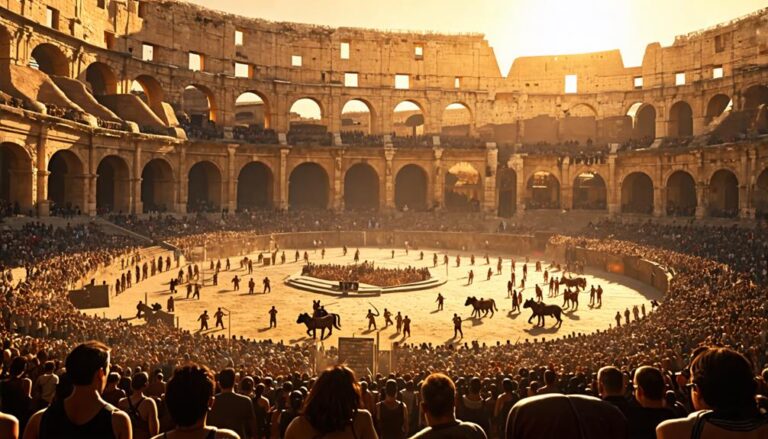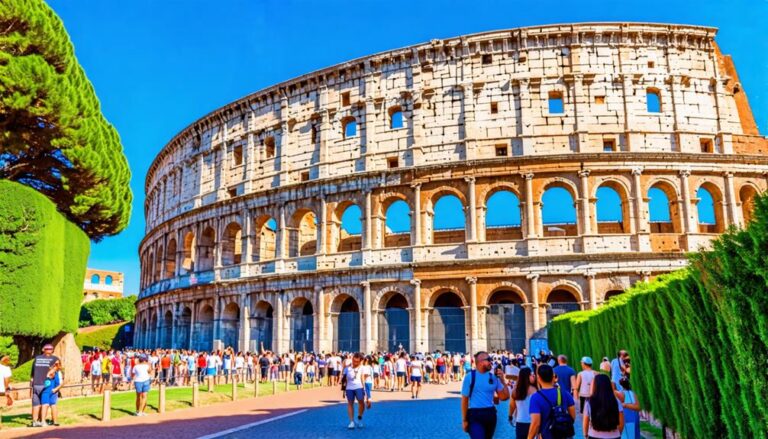Colosseum: Preservation and Restoration Efforts
The Colosseum is a must-see destination for anyone vacationing in Rome. This iconic structure, originally known as the Flavian Amphitheatre, has transformed over centuries into a well-preserved heritage monument.
Its preservation started back when it served as a medieval fortress and gained momentum in the 17th century with efforts focused on structural protection and stone conservation.
In 2013, modern restorations brought a new life to the Colosseum. Extensive cleaning, structural repairs, and new pathways have made it more accessible to visitors. Advanced techniques like 3D simulations ensure its stability. Ongoing archaeological studies continue to unveil hidden features, adding layers to its fascinating history.
The Colosseum stands as a symbol of Roman innovation and culture. Preservation efforts allow us to appreciate its legacy. These meticulous efforts have led to remarkable discoveries and exciting future plans.
So, when you’re planning your trip to Rome, make sure to include a visit to this magnificent monument.
Key Takeaways
- The Colosseum’s preservation began when the Frangipane family transformed it into a medieval fortress in the 12th-13th centuries. This historic site holds immense architectural and cultural significance.
- In the 16th century, a chapel was added, reflecting a shift towards preserving the Colosseum as a religious monument. This addition showcases the site’s evolving role through time.
- Systematic excavations in the 19th century uncovered hidden structures, including the hypogeum. These discoveries revealed the advanced engineering marvels of ancient Rome, making it a must-see for history buffs.
- Modern restoration efforts, funded by Tod’s since 2013, have significantly expanded public access from 15% to 85%. This makes the Colosseum more accessible to tourists eager to explore its grandeur.
Visitors to Rome should not miss the Colosseum. Its layers of history, from medieval fortresses to advanced Roman engineering, offer a unique glimpse into the past. The ongoing restoration ensures that this iconic landmark remains a stunning and safe destination for everyone.
Historical Context
The Colosseum, built between AD 70-80, stands as a testament to ancient Roman engineering and societal practices. Originally called the Flavian Amphitheatre, this grand structure hosted gladiatorial contests and public spectacles, showcasing the cultural vibrancy of Rome.
After the fall of the Roman Empire, the Colosseum’s destiny changed. Its stones were repurposed for other buildings, a practical reuse of resources in difficult times. During the 12th-13th centuries, the Colosseum became part of the Frangipane fortress, marking a significant shift in its function and preservation status.
When you vacation in Rome, visiting the Colosseum is a must. This architectural marvel tells a story of Rome’s rich history. Walking through its ancient arches, you can almost hear the echoes of the past. Imagine the roaring crowds and the fierce gladiators who once fought for their lives here. It’s not just a building; it’s a piece of living history.
Also, the Colosseum offers stunning views of Rome. Climb to the upper levels and you’ll get a panoramic view of the city. The surrounding area includes other iconic landmarks like the Roman Forum and Palatine Hill, making it a perfect spot for history buffs and casual tourists alike.
Early Preservation Attempts
When planning vacations to Rome, the Colosseum is a must-see landmark.
Exploring its history, you find that its transformation into a medieval fortress marked early attempts to repurpose and protect this iconic structure. By the 16th century, a chapel was added, showing ongoing efforts to maintain its historical essence. In the 17th century, preservation advocacy grew stronger, laying the groundwork for future restoration.
The Colosseum, Rome’s ancient amphitheater, stands as a testament to early preservation efforts. This majestic monument, once a medieval fortress, showcases the ingenuity of past generations in repurposing structures. Adding a chapel in the 16th century reflects the continuous interest in its upkeep. By the 17th century, the push for preservation became more robust, setting the stage for modern restoration.
When you visit Rome, the Colosseum offers a glimpse into a rich history. You’ll see how it evolved from a fortress to a protected heritage site. Early preservation efforts, including adding a chapel and increasing advocacy, highlight the importance of this majestic structure.
Enjoying this iconic landmark gives you a deep connection to Rome’s past.
Medieval Fortress Transformation
On your vacation to Rome, a visit to the Colosseum is a must. This iconic structure has a fascinating history. In the 12th-13th centuries, the Frangipane family transformed it into a fortress. This change marked an early attempt at preservation through adaptive reuse.
The medieval fortress transformation saw the construction of living quarters and defensive structures within the ancient Roman arena. These changes did cause some damage, but they also ensured the Colosseum’s survival during a chaotic period. The Frangipane family’s ingenuity in repurposing the Colosseum highlights an early recognition of the site’s lasting value.
They fortified the structure, adding battlements and other defensive features needed in medieval times. These modifications guaranteed the Colosseum remained part of Rome’s landscape. This adaptive reuse wasn’t modern preservation, but it set a precedent for the amphitheater’s continued existence.
Instead of being abandoned or dismantled, the Colosseum got a new lease on life. This transformation shows the importance of functional adaptation in preserving historical monuments. Thanks to these changes, the Colosseum remains a key part of Rome’s history, waiting for you to explore on your next Roman adventure.
16th Century Chapel Addition
In the 16th century, a chapel was built within the Colosseum. This marked an early attempt to preserve this iconic structure after its original function had ceased. The consecrated chapel altered the Colosseum’s interior, transforming it from an entertainment venue into a religious site. This change reflected the cultural values of the time. The Colosseum, once a stage for gladiatorial combat, became associated with Christian worship.
This addition signified a crucial step in the efforts to maintain the Colosseum. The chapel wasn’t just for religious ceremonies; it symbolized an effort to adapt and preserve the historic structure. By integrating this religious element, the Colosseum gained a new purpose, ensuring it wasn’t left to decay.
It’s fascinating to see how this early preservation showcased a shift in societal priorities. The transformation of the Colosseum into a site of Christian worship respected its historical significance while repurposing it to align with contemporary values. These early interventions laid the groundwork for more extensive preservation measures in subsequent centuries.
If you’re visiting Rome, the Colosseum is a must-see. This ancient amphitheater, with its layers of history, offers a unique glimpse into the past. You can imagine the roaring crowds during gladiatorial combats and the quiet moments of prayer in the chapel. Exploring the Colosseum lets you walk through centuries of history, making your vacation to Rome unforgettable.
17th Century Preservation Advocacy
Why did preservation efforts for the Colosseum gain momentum in the 17th and 18th centuries, leading to significant actions to protect this historic structure? During these centuries, the Colosseum’s historical and cultural significance was increasingly recognized, inspiring various early preservation attempts. People began to see the value in maintaining this ancient marvel, prompting several key protective measures.
When you visit Rome, the Colosseum is a must-see. Its grandeur and history captivate tourists from around the world. Did you know that significant steps to protect this iconic structure began in the 17th century?
Efforts were made to stop the removal of stones from the Colosseum, a common practice before. This was crucial in maintaining its integrity. The incorporation of the Colosseum into the Frangipane fortress during the 12th and 13th centuries showed an early tradition of preservation. This adaptive reuse helped keep the structure intact.
By the late 18th century, organized excavations began. These revealed the underlying structures, setting the stage for more methodical preservation work. In the 19th century, preservation advocacy led to extensive projects aimed at cleaning, reinforcing, and protecting the monument from further decay.
These actions were foundational in the journey to preserve the Colosseum. They ensure that future generations can appreciate its grandeur. The growing movement of preservation advocacy during this period highlighted the importance of safeguarding cultural heritage.
19th Century Excavations
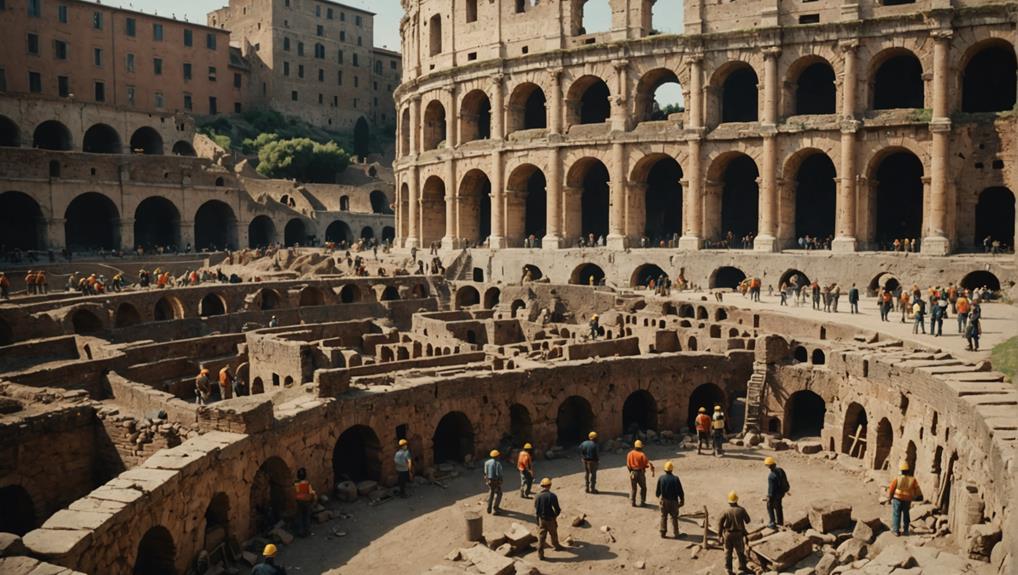
In the 19th century, systematic excavations of the Colosseum uncovered hidden structures, including a labyrinth of chambers and corridors. These archaeological findings, such as the hypogeum, gave essential insights into the monument’s historical and architectural significance.
Revealing these features provided valuable knowledge for both past and ongoing restoration efforts aimed at preserving the Colosseum’s original materials and construction techniques.
When you visit Rome, exploring the Colosseum is a must. Imagine walking through the same corridors that gladiators once used. The underground passages, known as the hypogeum, were essential for staging the grand spectacles that made the Colosseum famous.
This ancient engineering marvel shows the ingenuity of Roman architecture.
Rome offers a unique vacation experience. Stand in the Colosseum’s arena and feel the echoes of history. The monument’s grandeur, coupled with the stories it holds, makes it an unforgettable part of any trip to Rome.
The city itself is a living museum, where every corner tells a tale from a different era.
Revealing Hidden Structures
Systematic excavations in the 19th century uncovered the Colosseum’s hidden hypogeum. This complex network of tunnels housed gladiators and animals. These hidden structures, long buried beneath the arena’s surface, revealed the intricate operations of ancient Rome’s grand spectacles.
Exploring these discoveries is fascinating. The hypogeum wasn’t just a maze but a marvel of engineering. Detailed excavation work revealed:
- Elevators and pulleys: Ingenious systems for dramatic entrances of gladiators and beasts.
- Holding cells: Compartments where gladiators and animals awaited their turn.
- Trapdoors: Mechanisms that added surprise to the spectacles.
These findings provide insights into Roman engineering techniques and the operational logistics of the Colosseum. Restoration efforts, informed by these discoveries, now enable visitors to explore these hidden chambers. You can appreciate the historical significance of these underground marvels. By investing $33 million by 2016, we ensured that the Colosseum’s archaeological heritage captivates and educates future generations.
When planning your vacation to Rome, the Colosseum must be on your sightseeing list. The ancient amphitheater offers a unique glimpse into the past. Whether you’re interested in history, architecture, or simply want to marvel at Roman ingenuity, the Colosseum won’t disappoint.
Archaeological Discoveries Made
The 19th-century excavations at the Colosseum revealed incredible insights into ancient Roman engineering and entertainment. Archaeologists discovered the hypogeum, a complex network of tunnels and chambers beneath the arena floor. This hidden world housed gladiators and animals before their dramatic appearances, showing us the meticulous planning behind Roman spectacles.
We also found remnants of intricate machinery that facilitated elaborate shows, including mock sea battles. These discoveries provided evidence of the Colosseum’s original use, showcasing the Romans’ creativity in creating awe-inspiring experiences for their audiences. The excavations didn’t just stop at the hypogeum; they extended to the materials and construction techniques used in the Colosseum’s creation, deepening our understanding of ancient Roman engineering.
These archaeological studies have guided ongoing preservation efforts. By examining the original construction techniques and materials, we’ve developed strategies to maintain the Colosseum’s historical integrity. These findings guarantee that while we marvel at its grandeur, we also honor its past by preserving its structure as authentically as possible. The 19th-century excavations have played a pivotal role in both uncovering and safeguarding the Colosseum’s legacy.
When you visit Rome, the Colosseum stands out as a must-see landmark. Its majestic structure offers a window into the past, allowing you to imagine the grand spectacles that once took place. Walking through its ancient corridors, you can almost hear the echoes of the roaring crowds and feel the tension of the gladiatorial games. Whether you’re a history buff or just curious, the Colosseum promises an unforgettable experience.
Modern Restoration Initiatives
Since 2013, we’ve launched extensive restoration efforts to preserve and enhance the Colosseum’s structural integrity and visitor experience. These modern initiatives are crucial for maintaining this iconic structure for future generations. With a generous sponsorship of 25 million euros from Tod’s, we embarked on a comprehensive three-year project. This project focused on cleaning the travertine marble exterior and removing steel arches that marred the Colosseum’s appearance and stability.
Here’s what we’ve achieved so far:
- Structural repairs: Strengthening weakened areas to ensure long-term stability.
- Improved visitor access: Expanding public access from 15% to 85%, with new pathways and exhibitions.
- Collaborative expertise: Engaging over 80 professionals, including archaeologists and engineers.
These efforts have preserved the Colosseum and enhanced the visitor experience. By 2016, the total cost of these restoration efforts reached approximately 33 million dollars. Collaborative efforts and continuous archaeological studies funded through sponsorships are fundamental in keeping the Colosseum accessible and informative for everyone who visits.
If you’re planning a vacation to Rome, the Colosseum is a must-see. Its rich history and impressive architecture make it a highlight of any trip. These modern restoration initiatives ensure that visitors can experience the grandeur of ancient Rome in a safe and engaging way. From structural repairs to improved access, the enhancements make your visit more enjoyable.
Restoration Process
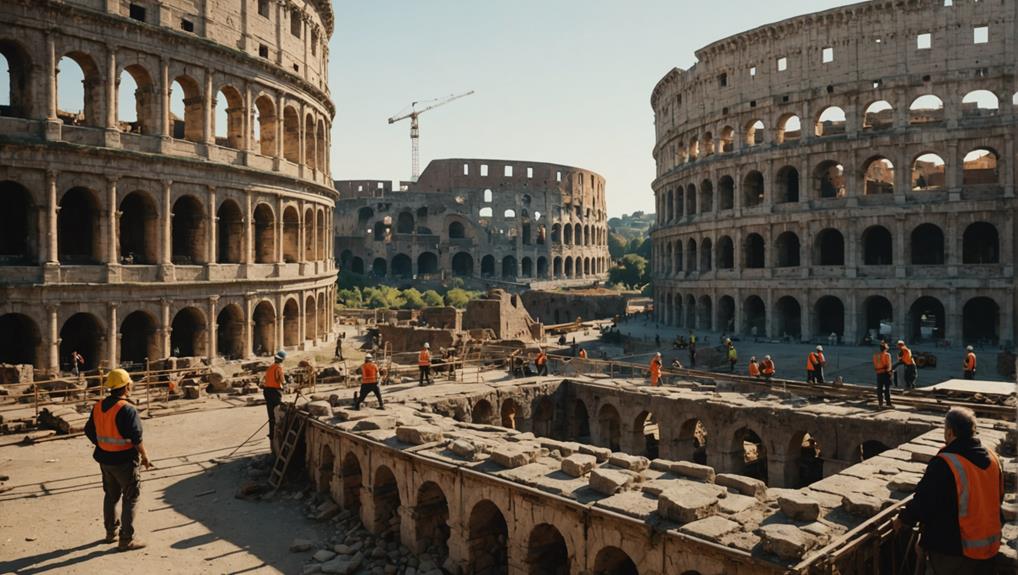
When planning a vacation to Rome, a visit to the Colosseum is a must-see experience. The Colosseum’s recent meticulous restoration has breathed new life into this iconic structure.
Starting in 2013, the restoration aimed to preserve its historical integrity and enhance visitor safety. This project included the first complete cleaning of its travertine marble exterior. This essential step restored its original, vibrant dark ivory color.
Structural integrity was crucial. Workers removed steel arches from ground level and repaired extensive cracks. These measures ensure the Colosseum’s stability for future generations. The restoration required collaboration among archaeologists, engineers, and conservators. Their work exemplifies the interdisciplinary approach needed for such a monumental task.
Impact on Visitors
The restoration efforts at the Colosseum have greatly enhanced the overall experience for visitors. The rejuvenated appearance and new features, like wooden paths and educational exhibitions, make the site more captivating. These improvements have also increased accessibility, allowing more exploration. With plans to make 85% of the Colosseum accessible, visitors will soon have unprecedented opportunities to engage with this iconic monument.
For those planning vacations to Rome, the Colosseum is now more inviting than ever. The blend of ancient history with modern amenities creates a unique atmosphere. You can walk on paths where gladiators once stood and learn through engaging exhibits.
The increased accessibility means more people can appreciate the grandeur of the Colosseum. Visitors can now explore various levels and hidden corners, gaining a deeper understanding of this historical marvel. The restoration aligns with historical evidence, ensuring authenticity while improving the visitor experience.
In short, the Colosseum’s enhancements make it a must-visit on any Rome sightseeing itinerary.
Enhanced Visitor Experience
Visitors to the Colosseum now enjoy a significantly upgraded experience thanks to extensive preservation and restoration efforts. The Roman Colosseum, a testament to ancient engineering brilliance, now offers a captivating mix of historical splendor and modern conveniences. These efforts have rejuvenated this iconic landmark, making it more attractive and educational for the six million annual visitors.
Key improvements include:
- Aesthetic Restoration: The cleaning of the travertine exterior has brought back its vibrant dark ivory color, greatly enhancing its visual charm.
- Safety Enhancements: The removal of steel arches for structural integrity ensures a secure environment, allowing exploration without worry.
- Expanded Access: New visitor paths and the opening of previously restricted areas have increased public access from 15% to 85%.
These enhancements not only preserve the Colosseum’s historical essence but also elevate the visit, offering a richer, more secure, and fascinating journey through time.
As you wander through the newly accessible corridors, you can appreciate the Colosseum’s legendary past while enjoying modern comfort and safety.
Increased Accessibility
The restoration efforts have dramatically increased accessibility, allowing us to explore and appreciate the Colosseum like never before. With the goal of boosting public access from 15% to 85%, these initiatives are transforming our experience. A newly installed 160-meter walkway now opens up previously inaccessible areas, enriching our engagement with this historic marvel. Plans to open the uppermost story will offer breathtaking panoramic views of Rome, making visits even more memorable.
About 6 million visitors come annually, and these accessibility improvements help manage this high demand while preserving the structure. New wooden paths and exhibitions further enhance learning opportunities within the Colosseum, making each visit a profound educational journey.
Key improvements include:
| Accessibility Feature | Description | Impact on Visitors |
|---|---|---|
| Public Access Increase | From 15% to 85% | More areas to explore and enjoy |
| 160-Meter Walkway | Access to previously restricted zones | Enhanced engagement with the monument |
| Uppermost Story Access | Panoramic city views | Enriched overall visitor experience |
These restoration efforts preserve the Colosseum and empower us to connect deeply with this iconic piece of history.
Architectural Features
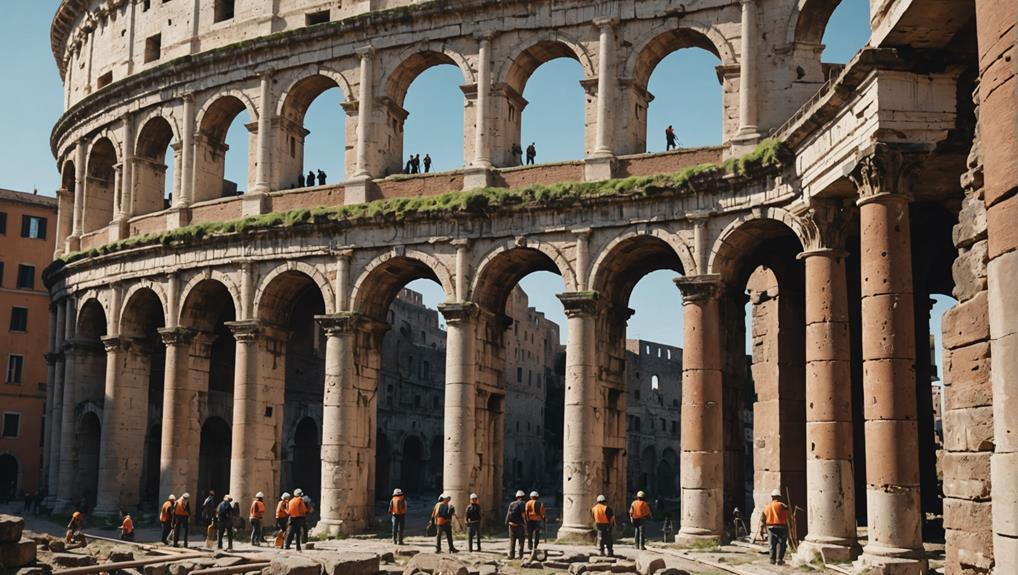
The Colosseum in Rome is a must-see on any vacation. Its elliptical design showcases ancient Rome’s engineering and architectural prowess. This iconic structure isn’t just a marvel of its time; it’s a testament to the ingenuity of Roman engineers. The Colosseum’s features are both practical and breathtaking, reflecting a deep understanding of space and function.
The elliptical shape allows for ideal viewing from any seat, ensuring that up to 50,000 spectators can enjoy the events. The arena floor, once covered in sand, served a dual purpose. It absorbed blood during gladiatorial games and provided a non-slip surface. Beneath this floor lies the hypogeum, a labyrinth of corridors and chambers that housed animals and gladiators.
The third tier offers expansive views of both the Colosseum’s interior and Rome’s surrounding landscapes. An intricate system of arches and vaults not only supports the Colosseum’s weight but also contributes to its lasting durability. The structure’s design facilitates crowd control and quick evacuation, a necessity for safety. The use of concrete and stone demonstrates advanced building techniques that were groundbreaking for their era.
These features aren’t just historical artifacts; they represent the spirit of Roman engineering and innovation. When in Rome, visiting the Colosseum is like stepping back in time to witness the grandeur of ancient civilization.
Challenges in Restoration
The Colosseum is a must-see when vacationing in Rome. Its architectural brilliance leaves visitors in awe.
However, the challenges in restoring this ancient marvel are significant. The complex structure requires expert knowledge and meticulous care. Environmental factors like pollution and underground construction vibrations speed up its deterioration.
Funding is another big hurdle. Without enough financial support, preservation projects slow down. This threatens the Colosseum’s longevity. Ongoing monitoring and repair work are crucial, especially with structural concerns about the fourth storey.
Preserving the original materials while ensuring structural stability is a delicate balance. Engineers and conservators work hard to maintain the Colosseum’s historical authenticity. These challenges aren’t just technical but also logistical and financial. They require a concerted effort from multiple stakeholders.
Despite these hurdles, our commitment to preserving the Colosseum remains strong. The journey is complex, but our dedication to this iconic symbol of history drives us forward. When you visit, you’ll see not just an ancient amphitheater but also the ongoing efforts to keep its legacy alive.
Innovative Techniques
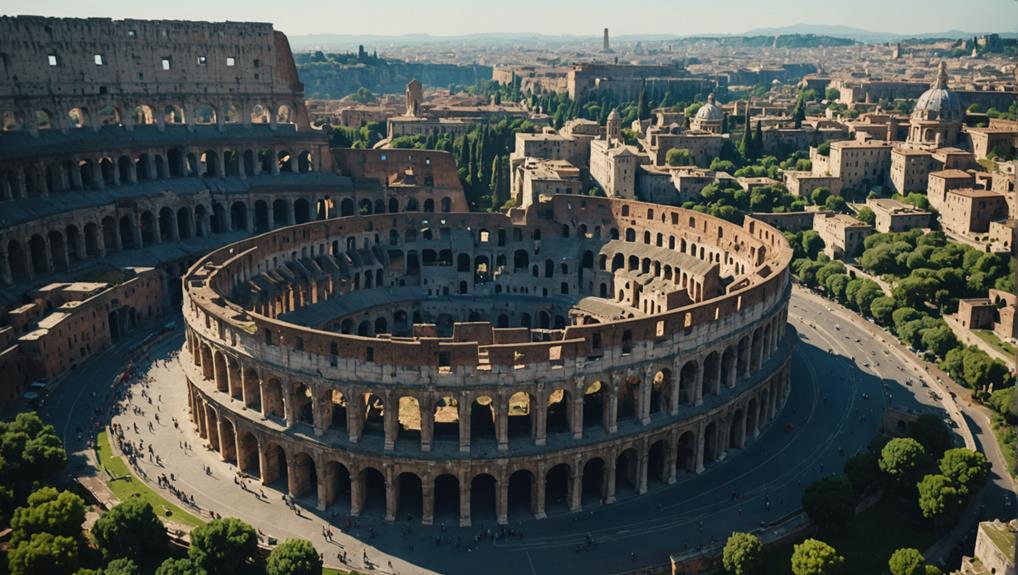
Modern technology breathes new life into the Colosseum’s preservation efforts, leveraging innovative techniques to safeguard its future. As we journey through these advancements, it’s clear that our approach to conservation is both meticulous and forward-thinking.
Engineers use gamma-ray spectroscopy to pinpoint the quarry sources of the materials used in the Colosseum’s construction. This technique enhances our understanding of ancient methods and helps us make more informed decisions about restoration.
Detailed imaging techniques allow us to create three-dimensional computer simulations of the structure. These simulations enable predictive modeling of the Colosseum’s response to vibrations, ensuring we can proactively address potential issues.
We’ve also installed a new locking system for the arches, considerably improving the Colosseum’s structural integrity without compromising its historical accuracy.
Additionally, the 160-meter walkway opens up areas that were once off-limits, offering the public a deeper connection with this monumental piece of history.
These innovative techniques ensure that the Colosseum remains resilient for future generations to explore and cherish.
- Gamma-ray spectroscopy: Identifies original quarry sources of construction materials.
- 3D computer simulations: Predicts structural responses to vibrations.
- New locking system for arches: Enhances structural integrity while preserving historical accuracy.
Underground Tour Insights
Stepping into the underground tour of the Colosseum, we uncover hidden chambers that once housed gladiators and animals before grand events. This part of the Colosseum, known as the hypogeum, is a labyrinth of tunnels and passageways. It included a clever system of elevators and pulleys that managed the spectacle of the games. These features showcase the engineering marvels of ancient Rome.
The hypogeum’s holding cells, characterized by their cramped and dark conditions, reveal the harsh realities faced by gladiators and captive animals. Navigating through these subterranean corridors, we gain a deeper understanding of the rigorous training regimens gladiators underwent. We also learn about the diverse range of animals used in the events, from exotic beasts to local wildlife.
Here’s a glimpse of what we encounter:
| Feature | Description |
|---|---|
| Hypogeum | Network of tunnels and passageways |
| Elevators & Pulleys | System for managing game spectacles |
| Holding Cells | Cramped, dark conditions for gladiators and animals |
| Training Insights | Details on gladiator training regimens |
| Animal Types | Various species used in Colosseum events |
Exploring these hidden depths, we appreciate the innovative design elements that allowed for such intricate operations. This offers us a unique perspective on ancient Roman entertainment and the incredible feats of engineering that made it possible.
Cultural Significance
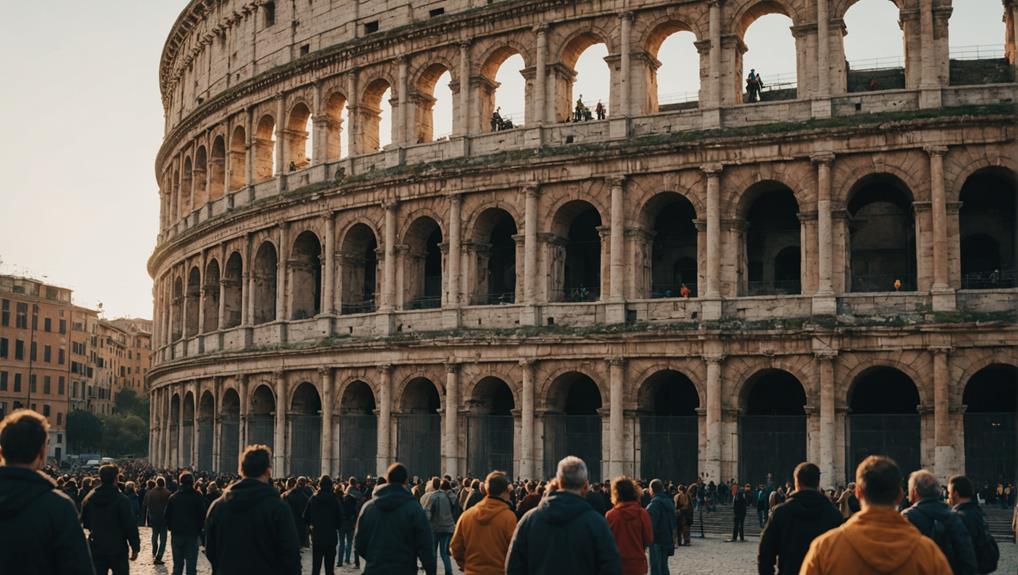
The Colosseum stands as a testament to the ingenuity and cultural impact of ancient Roman civilization. This iconic structure encapsulates the essence of Rome’s rich historical and cultural heritage.
The Colosseum’s cultural significance is evident in several key aspects:
- It inspired over 180 similar structures across the Roman Empire, showcasing its profound influence on ancient architecture.
- Recognized as a UNESCO World Heritage site, it draws millions of visitors annually, fostering a global appreciation for Roman history.
- Historical events such as gladiatorial games and public spectacles held here reflect the societal values of ancient Rome and have left a lasting cultural legacy.
When you visit Rome, the Colosseum isn’t just an architectural marvel. It’s a living representation of the cultural significance of ancient Rome.
Its influence extends beyond the past, impacting modern architecture and tourism alike. This timeless relevance underscores the importance of preserving the Colosseum, allowing us to connect with an era that valued freedom, innovation, and public spectacle.
Through these efforts, we honor a cornerstone of our shared human history.
Future Plans
As we honor the Colosseum’s cultural significance, future plans promise to unveil more of its historical mysteries and elevate visitor experiences. One of the most ambitious projects includes restoring the hypogea, the underground chambers that once housed gladiators and animals. This effort aims to increase visitor access from a mere 15% to an impressive 85%, allowing us to explore and appreciate the monument like never before.
Ongoing archaeological studies, generously funded by sponsorships, are expected to unearth new insights and artifacts related to the Colosseum’s storied past. By delving into these hidden layers, we get closer to understanding how this grand amphitheater functioned in ancient times.
Additionally, there’s excitement about the potential opening of the Colosseum’s uppermost story. Imagine the breathtaking, panoramic views of Rome from such a historic vantage point! These planned enhancements aren’t just about structural integrity; they’re about enriching our overall visitor experience through improved facilities and well-curated exhibitions.
The future plans for the Colosseum blend preservation and innovation, ensuring this iconic structure remains a dynamic representation of human history and ingenuity. By embracing these changes, we secure the Colosseum’s legacy for generations to come.
Frequently Asked Questions
What Is Being Done to Protect the Colosseum?
We’re enhancing visitor management with better access and safety measures. Restoration efforts include cleaning, structural reinforcement, and regular inspections. Using innovative techniques, we ensure this iconic site remains accessible and preserved for everyone to enjoy.
Rome’s Colosseum, a marvel of ancient engineering, continues to attract millions each year. To protect it, we’re using advanced technology for monitoring and preserving its structure.
Our team of experts performs regular maintenance checks. We employ sustainable practices to reduce wear and tear from daily visitors. Enhanced pathways make it easier for tourists to explore without causing damage.
Our commitment to preserving this UNESCO World Heritage Site ensures future generations can experience its grandeur. The Colosseum stands as a testament to Rome’s rich history and architectural brilliance.
What Is the Plan for Restoring the Colosseum?
Imagine exploring Rome’s wonders while the Colosseum gets a facelift. The restoration plan involves cleaning, reinforcing, and enhancing access to this ancient marvel. Structural reinforcements and new wooden paths will boost public access significantly.
Visitors will witness a blend of history and modern techniques. The aim is to preserve the Colosseum’s grandeur while making it more accessible for everyone. Combining ancient architecture with contemporary methods ensures the site’s longevity.
Your Roman vacation will include not just sightseeing but experiencing a piece of restored history. This project honors the past and welcomes future generations to explore the iconic Colosseum.
How Is the Roman Colosseum Protected?
When planning your vacation to Rome, visiting the Roman Colosseum is a must. The city protects this ancient amphitheater through careful restoration, advanced engineering methods, and strong structural reinforcements. These efforts ensure that future generations can explore and admire this iconic monument’s rich history and unique architecture.
Strolling through the Colosseum, you’ll marvel at its grandeur and intricate design. Built almost 2,000 years ago, it remains a testament to Roman engineering prowess. Today, preservation teams use cutting-edge technology to maintain its stability and authenticity.
Rome’s dedication to the Colosseum’s upkeep allows you to step back in time. As you walk the same paths as gladiators and emperors, you’ll gain a deeper appreciation for the cultural and historical significance of this ancient wonder.
Why Did They Not Fix the Colosseum?
We didn’t fix the Colosseum sooner due to its historical significance and the complex nature of its preservation. Environmental factors and millions of visitors contributed as well. Funding issues played a role. Fixing the Colosseum required meticulous planning and substantial resources.
When you plan your vacation to Rome, the Colosseum is a must-see landmark. This ancient amphitheater stands as a testament to Roman engineering and culture. Marvel at its grandeur, but remember it has faced centuries of wear and tear.
Historical records show that the Colosseum began to deteriorate after the fall of the Roman Empire. Earthquakes, stone robbers, and pollution added to its decline. Efforts to preserve it started in the 18th century, but only in recent decades have significant restorations occurred.
Your visit supports ongoing preservation. Ticket sales and donations fund conservation efforts. By seeing the Colosseum, you contribute to its future. Enjoy your trip and appreciate the layers of history in its weathered stones.
Conclusion
The Colosseum stands as a testament to Rome’s rich history and architectural brilliance. Each stone whispers tales of gladiators, emperors, and roaring crowds. Your vacation to Rome isn’t complete without visiting this iconic landmark. Embrace Rome’s past as you walk through the ancient archways.
Modern restoration efforts ensure the Colosseum remains an eternal symbol of human resilience. Advanced techniques, paired with time-honored methods, keep this historical wonder intact. Your visit supports these efforts, helping preserve a global treasure.
Imagine standing in the arena, where history comes alive. Feel the connection to a bygone era, and marvel at the ingenuity of ancient Roman engineers. The Colosseum’s future is bright, rooted in its storied past and our shared dedication to its upkeep.
Your journey through Rome promises unforgettable memories, with the Colosseum at its heart.
